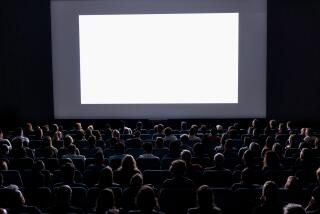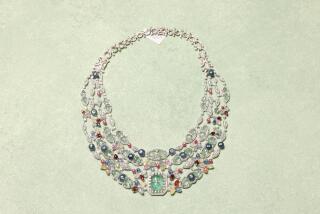Woody and his ‘Toy Story’ friends wait in the wings at toy fair
When Pixar Animation Studios guru John Lasseter was working on the original “Toy Story” movie, he approached the maker of Barbie to include the fashion doll in the film -- and was rebuffed.
What a difference 15 years, and $8 billion in global merchandise sales, make.
As Disney’s Pixar prepares to release “Toy Story 3” this summer, virtually every major toy maker -- including Barbie’s Mattel Inc. -- has lined up to make dolls, action figures, construction sets, vehicles and board games based on the film. No fewer than 250 toys will begin appearing in stores before the movie’s June 18 release -- three times as many as were made for “Toy Story 2.” And retailers are expected to clear shelf space for Buzz, Woody and pals, notwithstanding a recession that has slowed toy sales.
Children can be capricious about their choice of playthings, so toy sellers seek to protect themselves by investing in tested concepts.
“Managing risk is a big thing for retailers,” said John Frascotti, chief marketing officer of Hasbro Inc. “When an entertainment-backed property has all of the accouterments to go along with a film or TV show, just that cultural presence -- nothing is a sure bet in life -- mitigates the traditional risks.”
The toy industry is increasingly reliant upon Hollywood for characters and stories that kids will want to reenact in their homes. Toys tied to Hollywood’s publicity machine is one of few bright spots in a retail industry that has been stagnant: Sales of such toys rose 41% from 2004 through 2008, at a time when playthings without a TV or film hook fell 14%, according to toy maker Hasbro. And toys based on characters found in movies, TV shows or books accounted for $5.4 billion, or 25% of all U.S. toy sales, last year, research firm NPD estimates.
Underscoring that point, a toy based on “Bakugan Battle Brawlers,” a show that appears on Cartoon Network, claimed this year’s top prize for toys developed for boys -- for the second year in a row.
“Toy Story 3” isn’t the only movie attracting the toy industry’s attention at the New York toy fair, where performers portraying the film’s Green Army Men rappelled onto the stage during the unveiling of the toy line.
Marvel Entertainment’s sequel “Iron Man 2” was also sparking interest.
New York-based Marvel, newly acquired by Disney, courts not only older fans who grew up reading its comics but also 6- to 11-year-old boys who gravitate toward big muscles and heroic figures. After the box-office success of the 2008 film, retailers began clamoring to capitalize on toys pegged to the sequel, due out May 7.
“With [shelf space] such a precious commodity these days at retail, the retailers are looking for intellectual property with a tremendous amount of media behind it,” said Paul Gitter, Marvel Entertainment’s president of consumer products. “Marvel spends pretty aggressively behind its films.”
Hasbro, which holds the toy license, will sell a veritable armada of Iron Man action figures, a remote-controlled walking Iron Man and a helmet, gauntlet and chest light, so kids can transform themselves into the metal-clad Tony Stark character.
“The heroic nature of the brand and character . . . the fact that he uses lots of gadgets . . . the high-tech cool stuff that he does, are right in the wheelhouse for little boys,” Hasbro’s Frascotti said.
Of course, not every testosterone-fueled summer action film makes for a successful toy line. “Men in Black” and “Independence Day” landed with a thud in the toy aisles, said Sean McGowan, a toy analyst at Needham & Co. And an array of movie-derived toys glutted the market in the early 2000s, leading some manufacturers to scale back their plans.
Pixar’s Lasseter has long chafed at the reluctance of toy manufacturers and retailers to get behind original movies. In his induction speech to the Toy Hall of Fame on Saturday night, he recalled how North American toy buyers placed a scant 60,000 orders for Buzz Lightyear toys when “Toy Story” was released in 1995. Canadian manufacturer Thinkway Toys subsequently has sold 35 million of the figures.
“Toy Story,” though, is no longer an unknown quantity. The first two films raked in a combined $877 million at the box office and went on to sell tens of millions of DVDs, as well as inspire theme park attractions, video games and books that have been translated into 27 languages.
Interest in “Toy Story 3” was so intense that Disney invited competitive pitches, in which the manufacturers presented their ideas for the toy line, said Chris Heatherly, vice president of Disney toys in North America. Disney took the unusual step of not designating a single company as its “master licensee,” instead divvying up rights among a who’s who of the toy business: Mattel, Hasbro, Jakks Pacific Inc., Lego Group and Thinkway Toys.
Among the new toys are Mr. and Mrs. Potato Head dressed as movie characters Buzz, Woody and Jessie; a Buzz Lightyear Wing Pack with lighted plastic airfoils that extend and retract; a Lots-o’-Huggin’ Bear that is strawberry-scented and utters 45 sayings; a Western train set from Lego -- and Barbie and Ken dolls that, like the characters in the movie, are attired in 1980s-era Spandex and leg warmers (for her) and an ascot (for him).
“We look for . . . proven, classic intellectual properties that have longevity,” said Soren Torp Laursen, president of Lego Systems Inc. “Toy Story has proven it has a lot of longevity.”
dawn.chmielewski@ latimes.com






